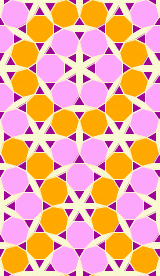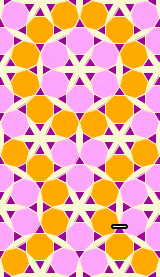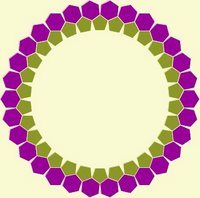 This pattern alternates two different orientations of pentagons. The pointing up ones are blue and the pointing down ones are purple. Notice that all but one of the pentagons (the central pentagon) are connected to exactly three other pentagons. The pattern can be thought of as concentric rings of pentagons (that will approximate decagons). Another way to understand the pattern is by grouping rhombi (the white diamond slivers) in terms of orientation--there are five different orientations. The rhombi form ten wedges that meet at the central pentagon.
This pattern alternates two different orientations of pentagons. The pointing up ones are blue and the pointing down ones are purple. Notice that all but one of the pentagons (the central pentagon) are connected to exactly three other pentagons. The pattern can be thought of as concentric rings of pentagons (that will approximate decagons). Another way to understand the pattern is by grouping rhombi (the white diamond slivers) in terms of orientation--there are five different orientations. The rhombi form ten wedges that meet at the central pentagon.
This blog is devoted to patterns made with polygons. I'll try to have something interesting posted regularly.
Tuesday, August 15, 2006
 This pattern alternates two different orientations of pentagons. The pointing up ones are blue and the pointing down ones are purple. Notice that all but one of the pentagons (the central pentagon) are connected to exactly three other pentagons. The pattern can be thought of as concentric rings of pentagons (that will approximate decagons). Another way to understand the pattern is by grouping rhombi (the white diamond slivers) in terms of orientation--there are five different orientations. The rhombi form ten wedges that meet at the central pentagon.
This pattern alternates two different orientations of pentagons. The pointing up ones are blue and the pointing down ones are purple. Notice that all but one of the pentagons (the central pentagon) are connected to exactly three other pentagons. The pattern can be thought of as concentric rings of pentagons (that will approximate decagons). Another way to understand the pattern is by grouping rhombi (the white diamond slivers) in terms of orientation--there are five different orientations. The rhombi form ten wedges that meet at the central pentagon.
Monday, August 14, 2006
 This pattern is somewhat like Friday's pattern in that it uses some sections of a big loop inverted to make a loop with a star shape. The pattern alternates heptagons and triangles with the exception of the orange hexagons in the middle (heptagons didn't fit). It also has a flavour of August first's pattern since it has the same type of rotational symmetry. I prefer the August first because it offers a lot of the same interesting lines yet with a simpler design.
This pattern is somewhat like Friday's pattern in that it uses some sections of a big loop inverted to make a loop with a star shape. The pattern alternates heptagons and triangles with the exception of the orange hexagons in the middle (heptagons didn't fit). It also has a flavour of August first's pattern since it has the same type of rotational symmetry. I prefer the August first because it offers a lot of the same interesting lines yet with a simpler design.
Sunday, August 13, 2006

 After a big battle with aesthetics, I finally settled on this pattern that makes a nice wall paper background (the image on the right). I'll highlight some of the battle. I originally started with a two colour pattern with just pink and purple. I thought it would have more impact than it did but I think with the regularity of the colouring that the pattern was dull. I added some colour it to make its bigger loops of twelve octagons and twelve triangles stand out. Even after I added orange to the mix it seemed too regular. The I introduced a twist to the pink loops of six octagons. To show you these transitions I'll added the pictures below. The key to recognizing the differences is to examine the negative space especially the asterisk like shapes. Notice there are two orientations in the pattern above as opposed to below where there is only one.
After a big battle with aesthetics, I finally settled on this pattern that makes a nice wall paper background (the image on the right). I'll highlight some of the battle. I originally started with a two colour pattern with just pink and purple. I thought it would have more impact than it did but I think with the regularity of the colouring that the pattern was dull. I added some colour it to make its bigger loops of twelve octagons and twelve triangles stand out. Even after I added orange to the mix it seemed too regular. The I introduced a twist to the pink loops of six octagons. To show you these transitions I'll added the pictures below. The key to recognizing the differences is to examine the negative space especially the asterisk like shapes. Notice there are two orientations in the pattern above as opposed to below where there is only one.



Saturday, August 12, 2006
 I guess that I've been a bit obsessed with pentagons and triangles recently. This is mostly an alternating pattern but has a couple of hexagons and triangles. I guess I like this one because of the central curved pentagon. I wish I was able to find a better way to fill the inside of the outer loop...
I guess that I've been a bit obsessed with pentagons and triangles recently. This is mostly an alternating pattern but has a couple of hexagons and triangles. I guess I like this one because of the central curved pentagon. I wish I was able to find a better way to fill the inside of the outer loop...
Friday, August 11, 2006
Thursday, August 10, 2006
Wednesday, August 09, 2006
 Sunflower
SunflowerThis pattern of a sunflower was a bit tricky to construct. The outer orange section (the petals) was easy given the high level of repetition but filling the insides (the seeds) was not straight forward. The pattern is built with alternating pentagons and triangles. The five-fold symmetry is present throughout the pattern.
Subscribe to:
Posts (Atom)
Popular Posts
-
Here's my take on Gödel, Escher, Bach cover in an attempt to start my new class, DATA ANALYTICS: PRINCIPLES & TOOLS. These were ...
-
This one was fun to make. I wanted a cool snowflake to be a backdrop for a presentation (http://prezi.com/jie04ey9bhjr/zulo/) that I wa...
-
Unlike normal, I was able to deliver the square version of the descending pentagons quickly. There was no math to figure out. although ...





